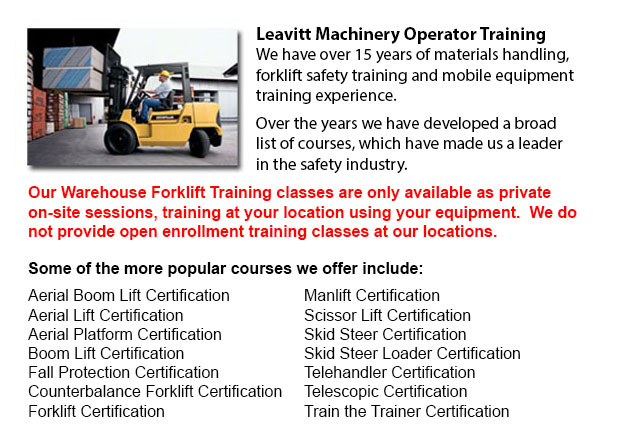
Warehouse Forklift Safety Training Edmonton - Companies often face liability for damage and injuries sustained in workplace accidents. Warehouses can be hazardous places to the people who work there. That is why employee safety is a top priority for numerous companies. Warehouse safety training is amongst the most effective methods to protect employees, while minimizing expenses connected with injuries and accidents.
Warehouses hold stock that could present various dangers, particularly related to materials handling. Moving stock, either manually or making use of powered machinery, could cause injuries to employees' fingers, hands, feet and toes. Slipping, tripping and falling are common reasons for injury. Heavy stuff can fall off shelves and harm workers. Forklifts and other machines carry inherent hazards because they manipulate heavily laden pallets. Improper lifting is a common source of back injuries. Even box cutters, nails and splinters could cause harm.
Depending upon the materials and goods that are being handled, the conditions of the warehouse could change from one minute to the next, particularly with the equipment being used and the tasks being performed. Due to the different possible dangers in warehouse settings, warehouse operations are regulated by many different standards. There are rules for material handling and storage, for working and walking surfaces, and regulations governing the selection and use of PPE (personal protective equipment).
Nearly all of the safety rules covered by a company will consist of common sense regulations. Rules that warehouse staff should be quite familiar with include:
1. Safety is a priority at all times if working in a warehouse.
2. When work calls for right PPE, like gloves, safety shoes, hard hats and eye protection, they must be worn.
3. Inspect for hazards and correct them or report them.
4. Observe and Follow warning signals and signs.
5. Pay attention to the tasks you are performing.
6. Pay attention to what others are performing nearby - specially forklifts and various hazardous machinery.
7. Stack and store materials so that they're stable and secure.
In order to ensure a safe warehouse, personnel must adhere to good housekeeping regulations. Essential rules for housekeeping involves keeping the floors and aisles clear of items such as wires and cords. Never perch things insecurely on a surface. When spills happen, clean up immediately. Dispose of trash in proper containers. Keep sprinklers, fire exits and fire extinguishers accessible. Put box cutters and other sharp tools away instantly after use. Report tripping hazards like for example loose or damaged flooring.
-
Forklift Training Programs Edmonton
Forklift Training Programs Edmonton - If you are searching for work as an operator of a forklift, our regulatory-compliant lift truck training programs provide excellent instruction in numerous styles and types of forklifts, classes on pre-shift insp... More -
Heavy Equipment Training School Edmonton
Heavy Equipment Training School Edmonton - The heavy equipment operator courses will assist the operator in acquiring the required skills and knowledge they will require to be able to enter the workforce as an entry level operator. In this 12 week co... More -
Manlift Ticket Edmonton
Manlift Ticket Edmonton - The Elevated Platforms and Manlifts Certification program helps to provide the necessary training on the safe operating procedures, work practice, rules and regulations regarding the daily activities for the operators of thi... More -
Crane License Edmonton
Crane License Edmonton - Crane operators must be "credentialed", which means they must have a crane operator license or certification. Credentialing is considered a mandatory governmental requirement in order to practice as a crane operator. Having a... More -
Counterbalance Forklift License Edmonton
Counterbalance Forklift License Edmonton - When operated by totally trained operators, forklifts could become a major advantage for firms and companies. We could offer your staff a comprehensive training program which covers all aspects of operating... More -
Manlift Safety Training Edmonton
Manlift Safety Training Edmonton - Manlift operators have to be aware and cognizant of all the potential hazards which are associated with particular types of scissor lifts. They need to be able to operate the scissor lift in a way that protects not... More -
Forklift Training School Edmonton
Forklift Training School Edmonton - Forklift Training School And Reasons Why It Is Really Important - Industry and federal regulators have established the criteria for forklift safety training based on their existing standards and regulations. Indivi... More -
Overhead Crane Safety Training Edmonton
Overhead Crane Safety Training Edmonton - The overhead crane safety training course is designed to equip the operators with the right skills and knowledge in the areas of: crane safety precautions, materials handling, accident avoidance, and equipmen... More

Forklift Training Edmonton
crossorigin="anonymous">
TOLL FREE: 1-888-254-6157
Edmonton, Alberta
forklifttrainingedmonton.com
Email Us
About Us


